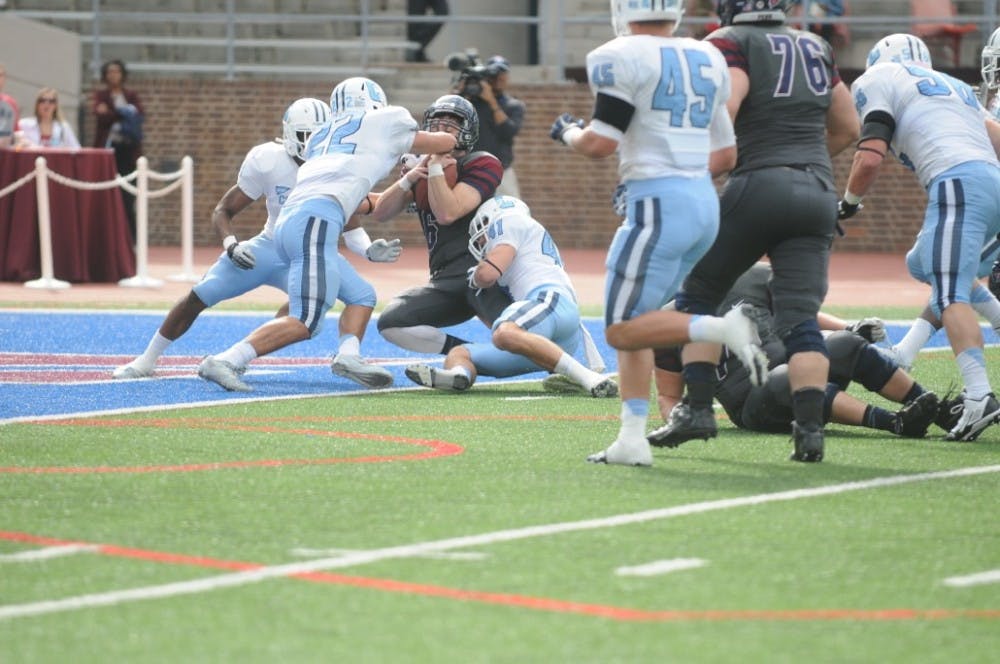
He got hit across the face on this play, but senior Eric Fiore also got a touchdown to tie the game at seven all. Fiore had just a total of three practices to learn running back after playing wide receiver his whole career, and with 89 all-purpose yards, he certainly acquitted himself well.
E n tering this season, it was easy to point to several of Penn football’s different units and marvel at the team’s depth.
Sure, while the offensive line lacked experience and sophomore quarterback Alek Torgersen was untested, the Red and Blue’s wide receiving corps, secondary and even their defensive front seven were laden with veterans.
With so many other storylines surrounding Penn, it was easy to overlook the squad’s deep backfield.
But the keys to success were there. With veteran Lyle Marsh returning from a year away from the team, he and bruising senior Kyle Wilcox seemed likely to split most of the team’s carries. That pair, combined with freshman Tre Solomon, offered what Bagnoli termed “three different styles to form a great 1-2-3 punch.”
Yet four games into the season, all three were injured. And even when any of the three were healthy, the Quakers struggled.
Save for Kyle Wilcox’s 67-yard touchdown scamper against Villanova — a score that ended up being the only points the team put on the board against the Wildcats — it is far easier to recall Penn’s 27 carries for 33 yards against Dartmouth.
Some of that could be the result of the Red and Blue’s adjustment to their new spread, up-tempo offensive system. Some of that could come from the caliber of Penn’s opponents. Some of it could be growing pains behind a relatively young offensive line.
Undoubtedly, Penn’s running game has failed to impress this season. Until Saturday, that is.
So with Penn’s top three out, the buck stopped with ... sophomore Brian Schoenauer?
Though a relative unknown for Penn fans, Schoenauer impressed in his first career start. The sophomore had 18 carries, picking up 77 of the team’s 276 total yards on the ground and consistently driving forward to gain extra yards.
Between Schoenauer and senior Eric Fiore, the Quakers were in good hands. Fiore’s 12-yard run in the first quarter knotted the game for Penn, and the duo consistently made the plays needed to help a sputtering team right the ship.
Not only did they provide relief to an offense that had thrown the ball 107 times in two games, the backs also set the tone for a winning game plan.
The numbers from the early portion of the Red and Blue’s season weren’t terrible. The team averaged 131.8 yards per game on the ground, a mark good enough for fifth in the Ivy League entering Saturday’s game.
But it’s important to remember that other than a strong performance against Jacksonville, the rest of the Quakers’ yard totals this year have been either supbar or meaningless. Ninety-seven yards against Villanova. Thirty-three against Dartmouth. And 187 in a 38-point loss to Fordham.
In Penn’s two best performances this season, first against Jacksonville and now against Columbia, the team has been able to run the ball. Sometimes, the recipe for success is that simple.
And while after the game Bagnoli mentioned that the lack of production from the running game has stemmed from the Quakers’ large deficits this year, it’s clear that Penn will need to establish its running game early and often — as it did on Saturday — if it wants to stay in the Ivy title chase.
While Saturday’s win may have come against Columbia, a team poised to go 0-for-the season once again, the Red and Blue’s ground production is a step in the right direction for the Quakers.
The Quakers’ depth at running back has finally revealed itself. Hopefully for them, it’s not too late.
The Daily Pennsylvanian is an independent, student-run newspaper. Please consider making a donation to support the coverage that shapes the University. Your generosity ensures a future of strong journalism at Penn.
DonatePlease note All comments are eligible for publication in The Daily Pennsylvanian.




